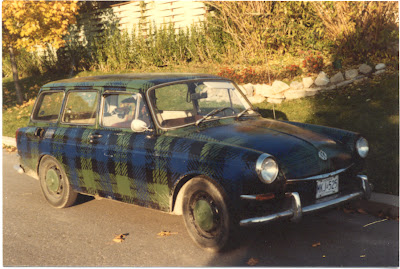 "Stripes?"
"Stripes?""There's hundreds of stripes."
"Dots?"
"Lots of dots on VW's"
"How about a sand car?"
Werner thought a VW covered with epoxy and then lightly sprinkled with sand would be the best. After another wobbly pop I suggested two-tone, using beach sand for some parts and then using white silica sand for the highlights.
"Maybe I'll weld fishhooks onto the body, like, all over it."
"Fishhooks?"
"Sure, like Don't Touch This Car, fishhooks."
We had a good laugh.
"How about a herringbone car?" I said. " "Paint it like a cream colour, and splatter it with little dots of paint (I was thinking of a jacket I'd picked up at a used clothing store with a herringbone pattern in it) and then paint the herringbone little dark V-shaped thingy's overtop of it." I took another drink. "But how do you get the stripes just right and even?"
"Use a roller," suggested Werner, belching. "A roller where you cut a pattern into it, then it rolls the pattern out and leaves the rest unpainted."
"How about plaid?"
"Yeah," he agreed. "Plaid." We discussed how to do it.
The next day I started with buying a paint roller with a plastic inner body and low pile fluff. It took a few hours of work with a razor blade to remove spiral layers of the roller surface and leave the in-between spaces blank. Of course, being in school I had to do it properly. I researched plaids. I decided on a Barclay Tartan, because, well... it was easy.
First I painted the whole car black. Then I used the roller to put yellow stripes over the whole car, front to back. Next I went from side to side. Each stripe was one roller width apart.
I had made a smaller roller and used it and brushes to paint the yellow stripes through the black and then make the white stripes over the broad yellow lines.
By the time I was finished there wasn't anything like it; at least not on this planet. York University was my school (and my home) at that time, so I decided to throw the love around and paint all sorts of plaid designs on the tunnels between buildings, friends walls and just about anywhere else.
Werner made his car into a "desert camouflage" by painting grey primer in patterns around the car. I don't have a photo. It was pretty good. Even better was a 'tree frog' design he did on a VW Beetle. I recognized it downtown and chased a surprised couple down, banging on their roof, to get a picture of it. Sorry, I don't have the picture anymore.
Going to Owen Sound in 1981 to learn about becoming a merchant marine officer I decided a plaid car in a small town might just get me into trouble, so I painted it over in black. The ridges and build-ups of paint underneath made it look pretty bed. A few years later I painted it with a dark blue and green plaid; the famous Black Watch tartan.
The car was thusly decorated when I started teaching in Scarborough schools, and for several years I was known as "Mr. Plaid Car".
The car died, alas, in 1984, when the final engine job (the eleventh) went bad. Not bad for a $400 car!


No comments:
Post a Comment